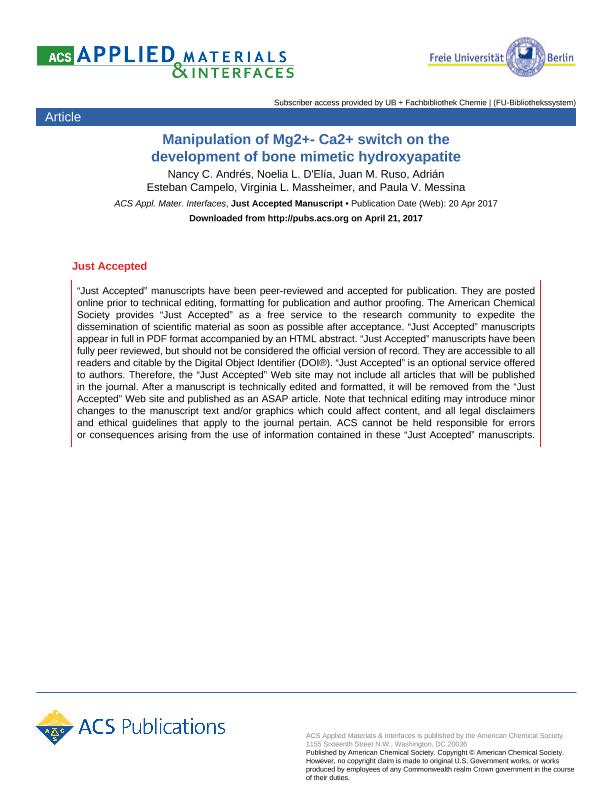Mostrar el registro sencillo del ítem
dc.contributor.author
Andrés, Nancy Carolina

dc.contributor.author
D'elía, Noelia Laura

dc.contributor.author
Ruso, Juan M.
dc.contributor.author
Campelo, Adrián Esteban

dc.contributor.author
Massheimer, Virginia Laura

dc.contributor.author
Messina, Paula Verónica

dc.date.available
2018-08-17T17:33:23Z
dc.date.issued
2017-05-20
dc.identifier.citation
Andrés, Nancy Carolina; D'elía, Noelia Laura; Ruso, Juan M.; Campelo, Adrián Esteban; Massheimer, Virginia Laura; et al.; Manipulation of Mg2+-Ca2+ Switch on the Development of Bone Mimetic Hydroxyapatite; American Chemical Society; ACS Applied Materials & Interfaces; 9; 18; 20-5-2017; 15698-15710
dc.identifier.issn
1944-8244
dc.identifier.uri
http://hdl.handle.net/11336/56203
dc.description.abstract
Ionic substitution can affect essential physicochemical properties leading to a specific biological behavior upon implantation. Therefore, it has been proposed as a tool to increase the biological efficiency of calcium phosphate based materials. In the following study, we have evaluated the contribution of an important cation in nature, Mg2+, into the structure of previously studied biocompatible and biodegradable hydroxyapatite (HA) nanorods and its subsequent effect on its chemical, morphology, and bone mimetic articulation. Mg2+-substituted HA samples were synthesized by an aqueous wet-chemical precipitation method, followed by an hydrothermal treatment involving a Mg2+ precursor that partially replace Ca2+ ions into HA crystal lattice; Mg2+ concentrations were modulated to obtain a nominal composition similar to that exists in calcified tissues. Hydrothermally synthesized Mg2+-substituted HA nanoparticles were characterized by X-ray powder diffraction, FT-NIR and EDX spectroscopies, field emission scanning and high resolution transmission electron microscopies (FE-SEM, H-TEM). Molecular modeling combining ab initio methods and power diffraction data were also performed. Results showed that Mg2+-substitution promoted the formation of calcium deficient HA (cdHA) where Mg2+ replacement is energetically favored at Ca(1) position in a limited and specific amount directing the additional Mg2+ toward the surface of the crystal. The control of Mg2+ incorporation into HA nanorods gave rise to a tailored crystallinity degree, cell parameters, morphology, surface hydration, solubility, and degradation properties in a dose-replacement dependent manner. The obtained materials show qualities that conjugated together to drive an optimal in vitro cellular viability, spreading, and proliferation confirming their biocompatibility. In addition, an improved adhesion of osteoblast was evidenced after Mg2+-Ca2+ substitution.
dc.format
application/pdf
dc.language.iso
eng
dc.publisher
American Chemical Society

dc.rights
info:eu-repo/semantics/openAccess
dc.rights.uri
https://creativecommons.org/licenses/by/2.5/ar/
dc.subject
Calcified Tissues
dc.subject
Cell Proliferation
dc.subject
Hydroxyapatite
dc.subject
Magnesium Substitution
dc.subject.classification
Otras Ciencias Químicas

dc.subject.classification
Ciencias Químicas

dc.subject.classification
CIENCIAS NATURALES Y EXACTAS

dc.title
Manipulation of Mg2+-Ca2+ Switch on the Development of Bone Mimetic Hydroxyapatite
dc.type
info:eu-repo/semantics/article
dc.type
info:ar-repo/semantics/artículo
dc.type
info:eu-repo/semantics/publishedVersion
dc.date.updated
2018-08-10T16:22:41Z
dc.journal.volume
9
dc.journal.number
18
dc.journal.pagination
15698-15710
dc.journal.pais
Estados Unidos

dc.journal.ciudad
Washington DC
dc.description.fil
Fil: Andrés, Nancy Carolina. Consejo Nacional de Investigaciones Científicas y Técnicas. Centro Científico Tecnológico Conicet - Bahía Blanca. Instituto de Química del Sur. Universidad Nacional del Sur. Departamento de Química. Instituto de Química del Sur; Argentina
dc.description.fil
Fil: D'elía, Noelia Laura. Consejo Nacional de Investigaciones Científicas y Técnicas. Centro Científico Tecnológico Conicet - Bahía Blanca. Instituto de Química del Sur. Universidad Nacional del Sur. Departamento de Química. Instituto de Química del Sur; Argentina
dc.description.fil
Fil: Ruso, Juan M.. University of Santiago de Compostela; España
dc.description.fil
Fil: Campelo, Adrián Esteban. Consejo Nacional de Investigaciones Científicas y Técnicas. Centro Científico Tecnológico Conicet - Bahía Blanca. Instituto de Ciencias Biológicas y Biomédicas del Sur. Universidad Nacional del Sur. Departamento de Biología, Bioquímica y Farmacia. Instituto de Ciencias Biológicas y Biomédicas del Sur; Argentina
dc.description.fil
Fil: Massheimer, Virginia Laura. Consejo Nacional de Investigaciones Científicas y Técnicas. Centro Científico Tecnológico Conicet - Bahía Blanca. Instituto de Ciencias Biológicas y Biomédicas del Sur. Universidad Nacional del Sur. Departamento de Biología, Bioquímica y Farmacia. Instituto de Ciencias Biológicas y Biomédicas del Sur; Argentina
dc.description.fil
Fil: Messina, Paula Verónica. Consejo Nacional de Investigaciones Científicas y Técnicas. Centro Científico Tecnológico Conicet - Bahía Blanca. Instituto de Química del Sur. Universidad Nacional del Sur. Departamento de Química. Instituto de Química del Sur; Argentina
dc.journal.title
ACS Applied Materials & Interfaces

dc.relation.alternativeid
info:eu-repo/semantics/altIdentifier/url/https://pubs.acs.org/doi/10.1021/acsami.7b02241
dc.relation.alternativeid
info:eu-repo/semantics/altIdentifier/doi/http://dx.doi.org/10.1021/acsami.7b02241
Archivos asociados
